If you’re looking to make the most of a small outdoor space, creating an efficient garden design plan is key. This guide highlights practical tips and clever ideas that can help you maximize your garden’s potential, allowing you to enjoy a lush, green retreat without needing a massive yard. Let’s jump right into it!
Seasonal Plant Selection

Choosing the right plants for your small garden can make all the difference. The image shows a vibrant mix of flowers, each labeled with their names, making it easy to identify them. This colorful arrangement highlights how seasonal selections can bring life to your outdoor space.
In spring, consider flowers like the pink and yellow blooms seen here. They add a cheerful touch and thrive in warmer weather. As summer approaches, zinnias and daisies can offer a burst of color and attract pollinators. These flowers are not only beautiful but also easy to care for.
For fall, think about incorporating plants that can withstand cooler temperatures. The garden in the image suggests a variety of options that can transition smoothly from one season to the next. Mixing and matching seasonal plants keeps your garden looking fresh and inviting throughout the year.
Vertical Gardening Solutions
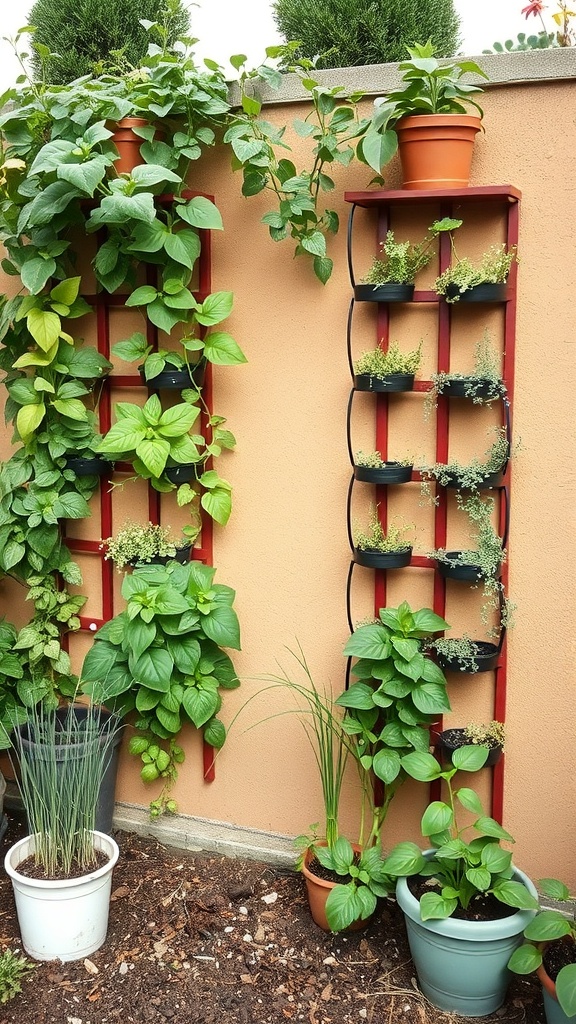
Vertical gardening is a fantastic way to maximize space, especially in small gardens. The image shows a clever setup with two vertical planters against a wall. These planters are perfect for growing herbs and small plants, making them ideal for urban gardening.
The left side features a lush green vine cascading down, adding a touch of nature to the space. On the right, you can see a structured arrangement of pots, each filled with different herbs. This setup not only saves space but also creates a visually appealing garden.
Using vertical gardening solutions like these can transform any small area into a vibrant green retreat. They allow you to grow your favorite plants while keeping your garden organized and tidy. Plus, it’s a great way to bring some greenery into your living space!
Water Features for Serenity
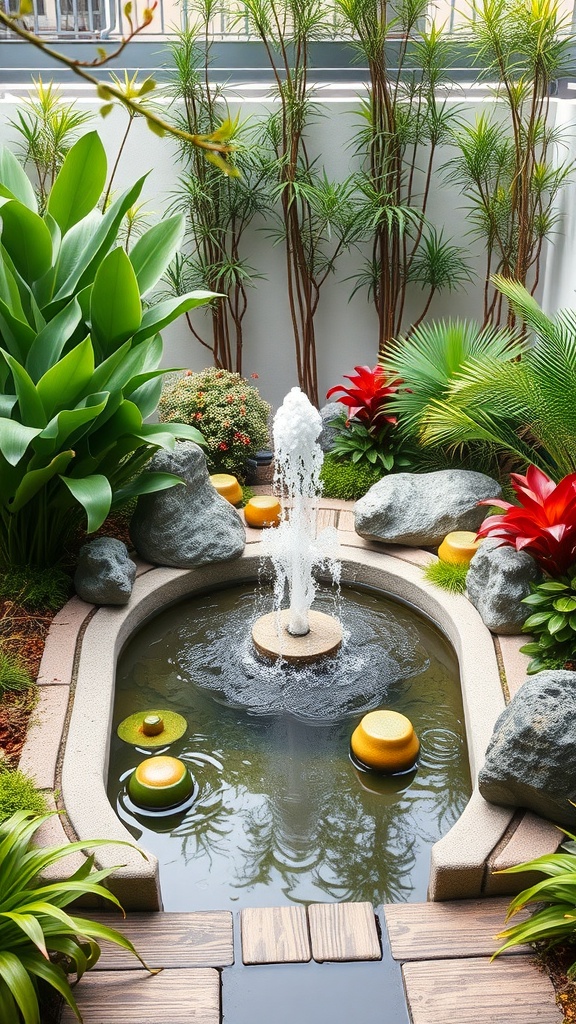
Water features can transform a small garden into a peaceful retreat. The image shows a lovely pond with a fountain at its center, surrounded by lush greenery and colorful plants. This setup invites relaxation and tranquility.
The gentle sound of water flowing creates a calming atmosphere. It’s perfect for unwinding after a long day. The fountain not only adds beauty but also helps to aerate the water, keeping it fresh for any fish or plants you might want to include.
Incorporating stones and vibrant plants around the pond enhances the natural look. You can choose various plants that thrive in moist conditions to complement the water feature. This design encourages wildlife, like birds and butterflies, to visit, adding life to your garden.
Whether you have a large or small space, a water feature can be a focal point that brings joy and serenity. It’s a simple way to elevate your garden design and create a peaceful escape right at home.
Incorporating Pathways for Flow
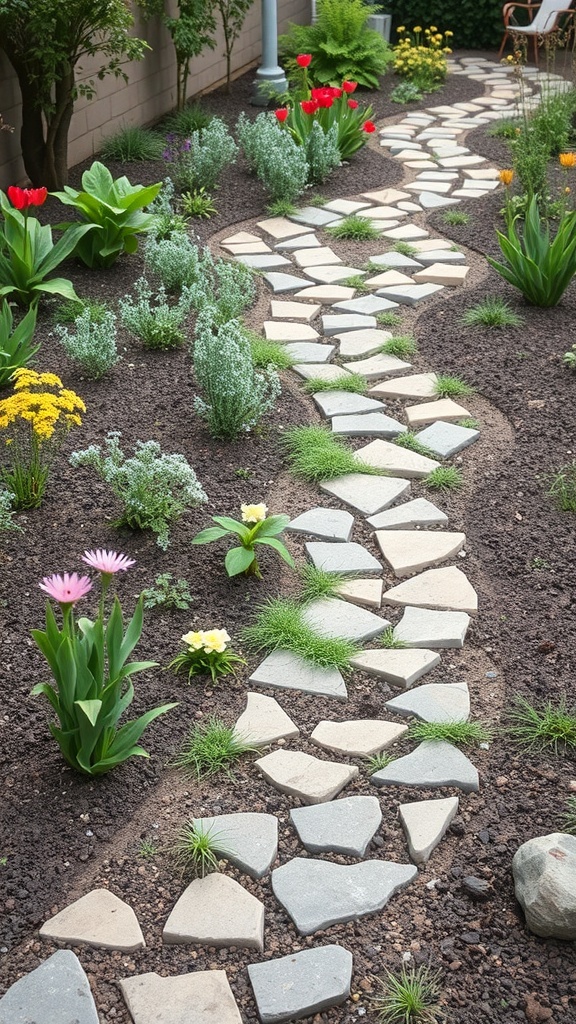
Pathways in a small garden can make a big difference. They guide visitors through the space, creating a sense of flow. The image shows a charming winding path made from stone, surrounded by vibrant flowers and greenery.
This design not only looks inviting but also serves a practical purpose. The stones create a clear route, making it easy to navigate the garden. The mix of colors from the flowers adds a lively touch, enhancing the overall appeal.
When planning your garden, think about how pathways can connect different areas. You might want to lead from a seating area to a flower bed or a vegetable patch. This encourages exploration and enjoyment of the space.
Incorporating pathways can also help define areas within your garden. For example, a path can separate a flower garden from a vegetable patch, making each section feel distinct yet connected. This approach adds structure while maintaining a natural feel.
Creating a Cozy Seating Area
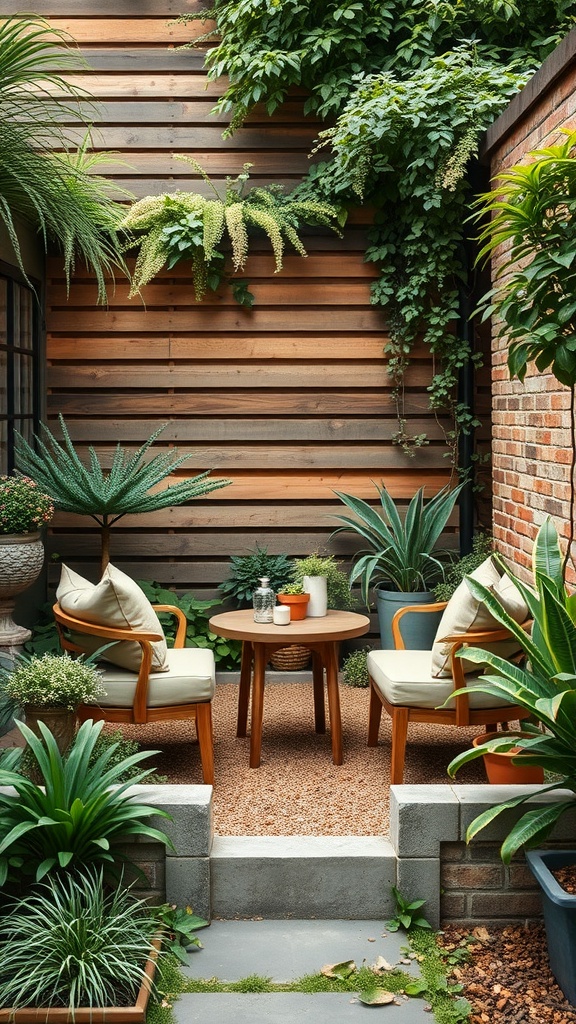
Designing a small garden can be a fun and rewarding project. One of the best ways to make the most of your space is by creating a cozy seating area. This spot can serve as a perfect retreat for relaxation or a gathering place for friends.
In the image, you can see a charming seating arrangement featuring two comfortable chairs and a small table. The natural materials and soft cushions invite you to sit back and enjoy the surroundings. The gravel floor adds a rustic touch, making it feel warm and welcoming.
Surrounding the seating area are lush plants that bring life and color to the space. The greenery not only enhances the visual appeal but also creates a sense of privacy. This makes it an ideal spot for enjoying a morning coffee or reading a book in the afternoon sun.
When planning your own cozy seating area, think about the layout and how you want to use the space. Choose furniture that fits well and complements the garden’s style. Adding small decorative elements, like candles or potted plants, can further enhance the charm of your seating area.
Utilizing Raised Garden Beds
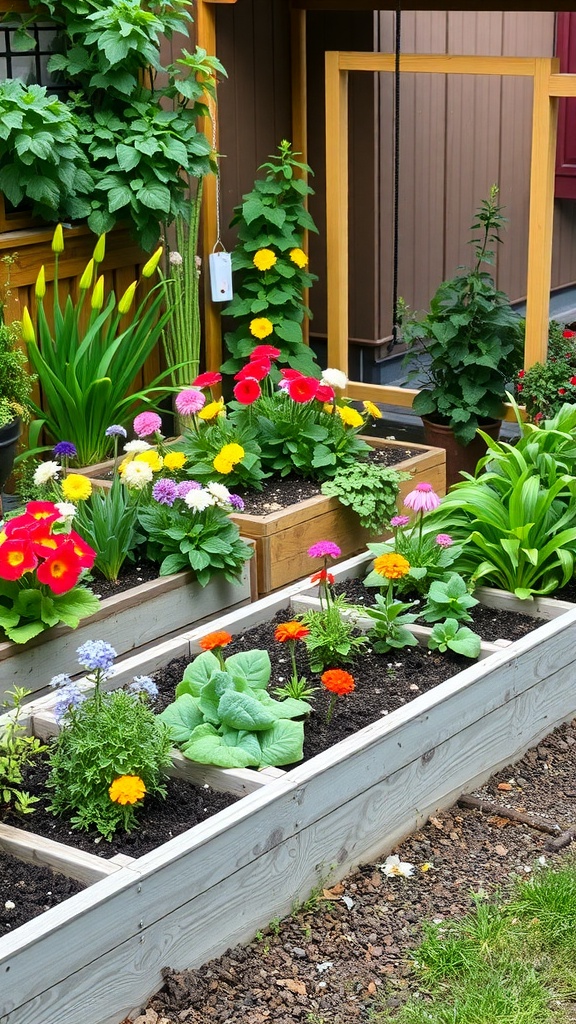
Raised garden beds are a fantastic way to maximize space in a small garden. They allow you to grow a variety of plants while keeping everything organized. The image shows a vibrant display of flowers and vegetables in neatly arranged raised beds. This setup not only looks appealing but also makes gardening easier.
One of the main benefits of raised beds is improved soil drainage. This is especially helpful if your garden area has heavy clay soil. With raised beds, you can fill them with a mix of quality soil and compost, giving your plants the nutrients they need to thrive.
Another advantage is that raised beds can be built to a height that suits you. This means less bending and kneeling, making gardening more accessible for everyone. The colorful flowers and healthy vegetables in the image highlight how raised beds can create a lively and productive garden space.
When planning your raised garden beds, think about the types of plants you want to grow. Mixing flowers with vegetables can attract beneficial insects and pollinators. The combination of colors and textures can turn your small garden into a beautiful retreat.
Creative Container Arrangements
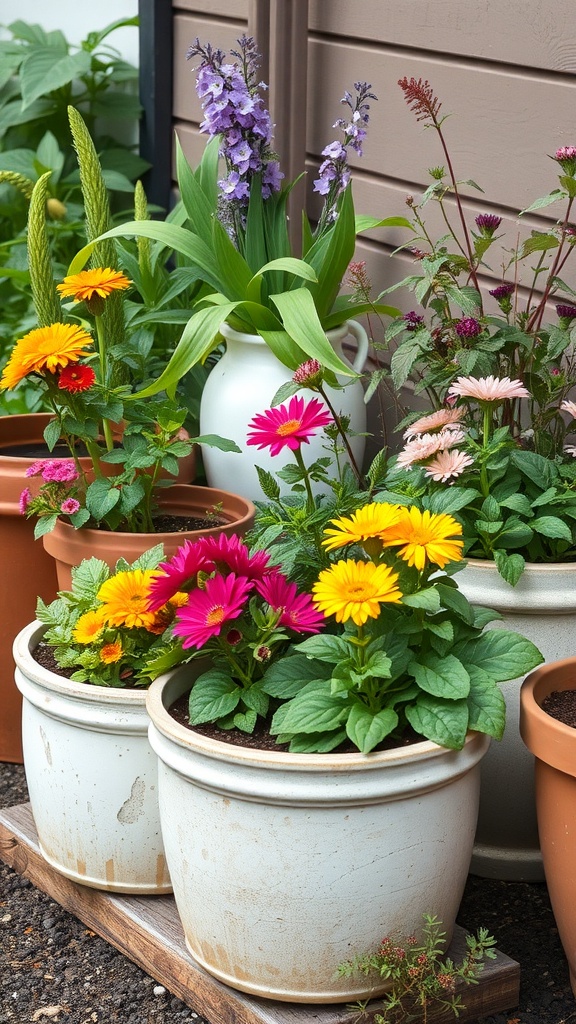
Container gardening is a fantastic way to add color and life to small spaces. The image showcases a lovely arrangement of vibrant flowers in various pots. Each container is filled with cheerful blooms, creating a lively atmosphere.
The bright yellows, pinks, and purples of the flowers stand out beautifully against the neutral tones of the pots. This mix of colors not only draws the eye but also brings joy to any garden. Using different sizes and shapes of containers can add depth and interest to your design.
Incorporating greenery alongside the flowers adds texture and balance. The tall, leafy plants in the background complement the shorter blooms in the foreground, creating a layered look. This arrangement is perfect for patios, balconies, or any small garden area.
When planning your container garden, think about the sunlight and water needs of each plant. Grouping plants with similar requirements can make maintenance easier. With a little creativity, you can transform any small space into a vibrant garden oasis.
Using Edible Plants in Design
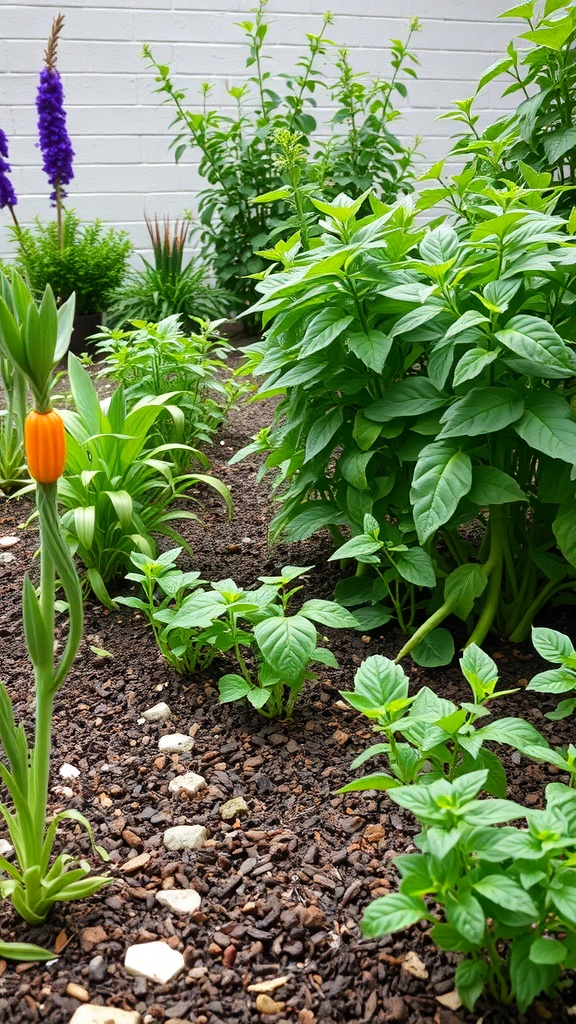
Incorporating edible plants into your garden design can be a fun and rewarding experience. The image shows a vibrant small garden filled with various plants, including herbs and vegetables. This not only adds beauty but also provides fresh ingredients for your meals.
Consider planting herbs like basil and mint alongside vegetables such as potatoes. These plants thrive together and can create a lush, green space. The colorful flowers in the background add a nice touch, making the garden visually appealing while still being functional.
Using edible plants allows you to enjoy the fruits of your labor. Imagine stepping outside to pick fresh basil for your pasta or potatoes for a hearty stew. It’s a great way to connect with nature and enjoy homegrown flavors.
When planning your garden, think about the layout. Grouping plants with similar needs can help them flourish. Paths made of stones, like those seen in the image, can make it easy to navigate your garden while adding charm.
Seasonal Decor Enhancements
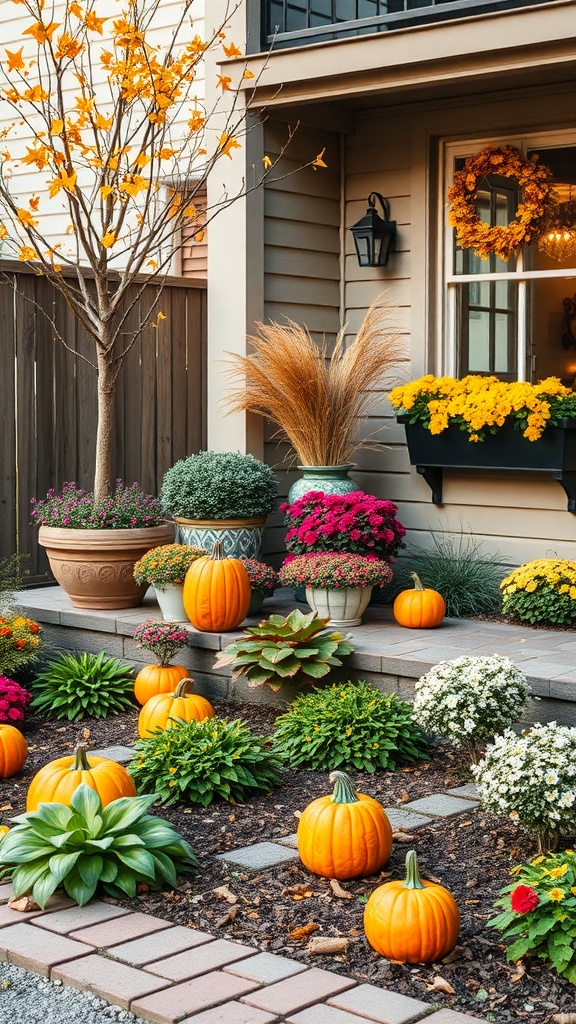
Transforming your small garden for the seasons can be a fun and rewarding task. The image showcases a charming autumn scene, filled with vibrant colors and seasonal elements. Pumpkins, colorful flowers, and decorative plants create a warm and inviting atmosphere.
Incorporating pumpkins is a classic fall touch. They add a pop of orange that contrasts beautifully with the greens and yellows of the plants. Grouping them in clusters can create visual interest and draw the eye.
Flowers like chrysanthemums and ornamental grasses provide texture and depth. They not only enhance the garden’s beauty but also celebrate the season’s bounty. Consider using pots to elevate some plants, adding layers to your garden design.
Don’t forget about the little details! A wreath on the door or decorative lanterns can tie the whole look together. These small touches make your garden feel cozy and welcoming, perfect for enjoying the crisp autumn air.
Incorporating Garden Art
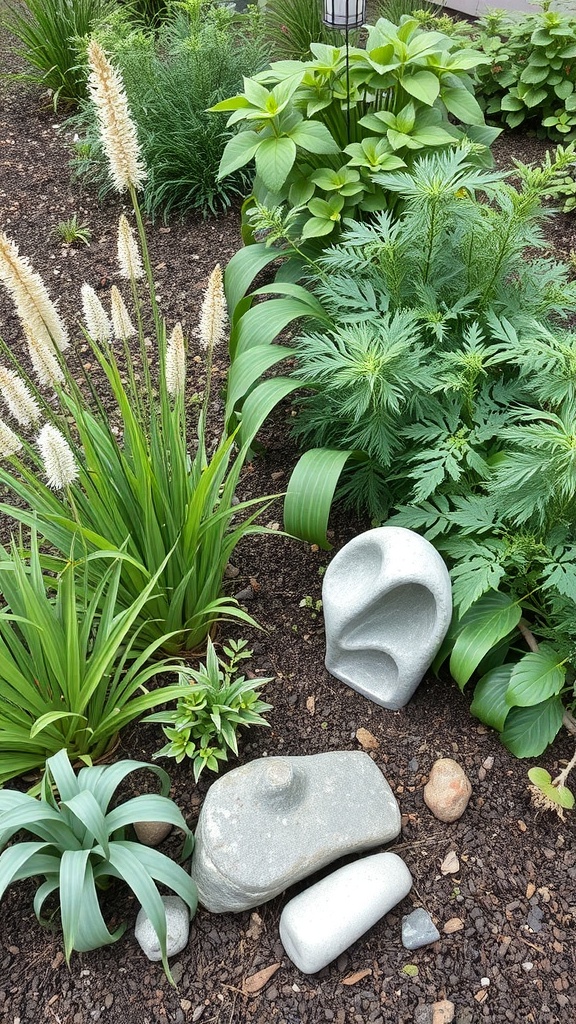
Adding art to your garden can bring a unique touch to your outdoor space. The image shows a lovely arrangement of stone sculptures nestled among vibrant plants. These pieces not only enhance the visual appeal but also create focal points that draw the eye.
The smooth, abstract shapes of the stones contrast beautifully with the lush greenery. This mix of textures and forms adds depth to the garden. You can choose sculptures that resonate with your style, whether they are modern, rustic, or whimsical.
Consider placing art in strategic spots where it can be appreciated from different angles. This way, every visit to your garden feels fresh and engaging. Don’t shy away from experimenting with different materials, like metal or wood, to complement your plants.
Incorporating Wildlife-Friendly Elements
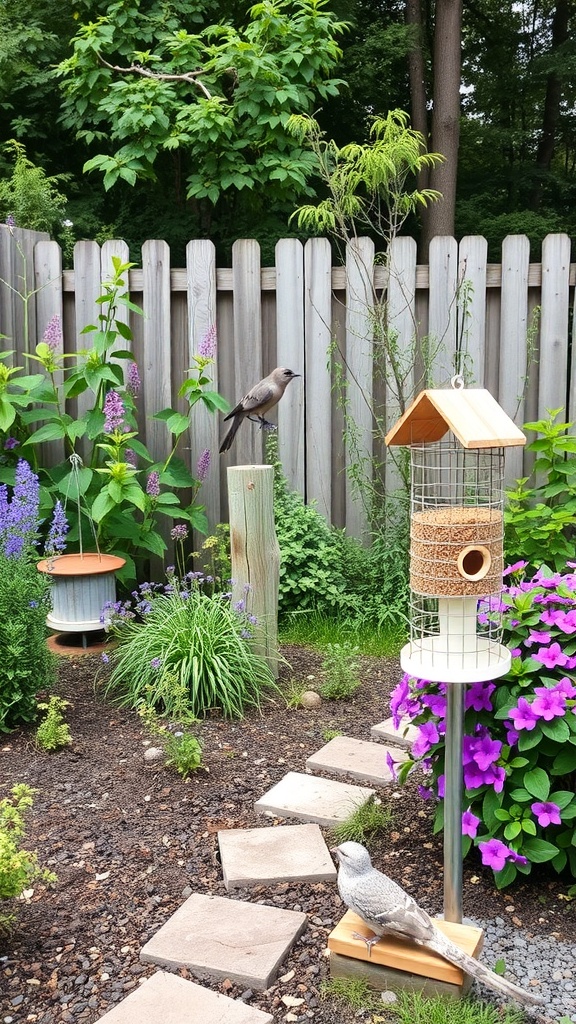
Creating a small garden can be a delightful way to connect with nature. In this image, we see a charming setup that invites local wildlife into the space.
The bird feeder, with its unique design, is a fantastic addition. It not only provides food for birds but also adds a decorative touch. The vibrant flowers surrounding it attract various species, making the garden a lively spot.
Notice the stepping stones leading through the garden. They create a welcoming path, encouraging visitors to explore. This design element is practical and enhances the garden’s overall appeal.
Adding plants that bloom at different times ensures there’s always something for the birds and insects. The mix of colors and textures creates a visually pleasing environment.
Incorporating these wildlife-friendly elements not only supports local ecosystems but also brings joy to anyone who spends time in the garden. It’s a simple way to make a big difference.
Lighting for Ambiance
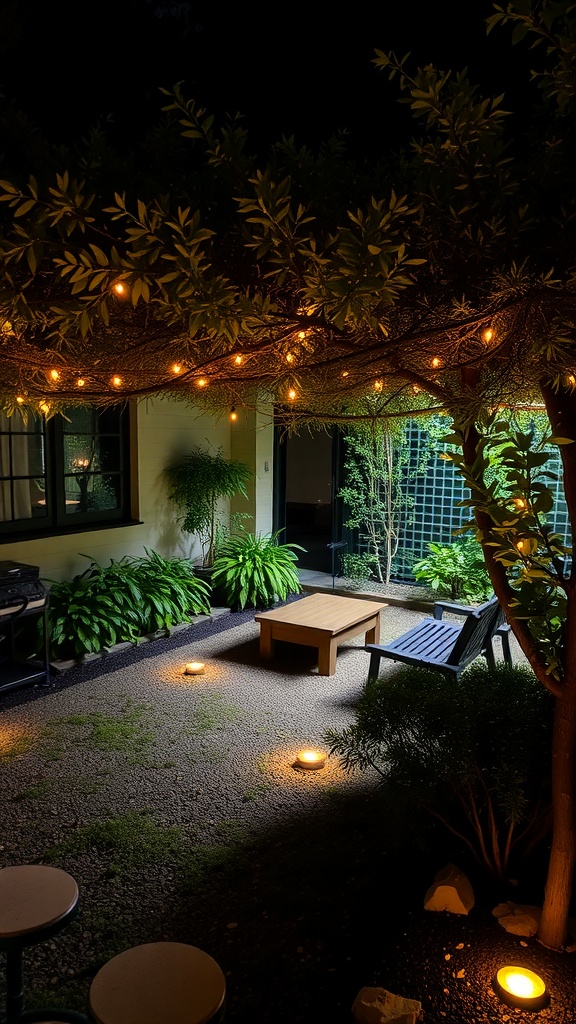
Creating a cozy atmosphere in your small garden is all about the right lighting. The image shows a charming outdoor space illuminated by warm lights. These lights hang gracefully above, adding a magical touch to the setting.
Notice how the soft glow from the ground lights highlights the gravel and plants. This not only enhances the beauty of the garden but also makes it feel inviting. The combination of overhead and ground lighting creates layers, making the space feel more expansive.
Consider using string lights for a whimsical feel. They can be draped over trees or along fences. Ground lights can be placed strategically to guide the way or to spotlight certain features, like a lovely plant or seating area. This thoughtful lighting design can transform your garden into a perfect spot for relaxation or entertaining.
Creating Privacy with Greenery

In a small garden, creating privacy can be a fun challenge. The image shows a cozy space surrounded by lush greenery. Tall, dense plants form natural walls, offering a sense of seclusion. This setup is perfect for relaxing or enjoying a quiet moment.
The pathway made of stone and grass adds charm while guiding you through the garden. A simple bench invites you to sit and soak in the beauty around you. The mix of textures from the plants and the seating area creates a warm and inviting atmosphere.
Using greenery for privacy not only looks good but also enhances your outdoor experience. It’s a great way to block out noise and distractions from the outside world. With the right plants, you can achieve a peaceful retreat right in your backyard.
Maximizing Sunlight Exposure
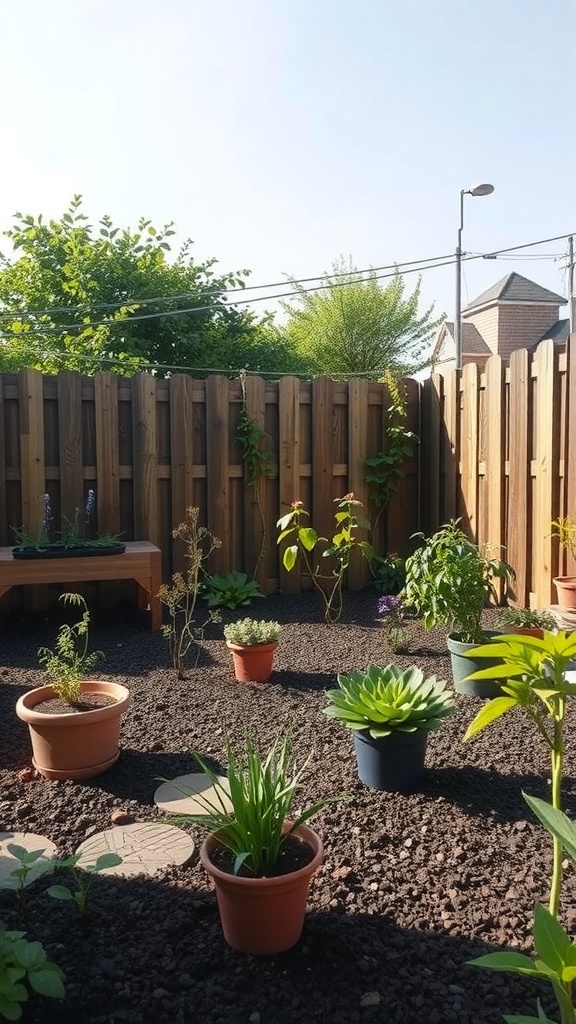
In a small garden, sunlight is key to healthy plants. The image shows a cozy garden space filled with various potted plants. The arrangement allows for plenty of light to reach each plant, which is essential for their growth.
Notice how the taller plants are placed towards the back or sides. This setup prevents them from shading smaller plants. It’s a smart way to ensure that every plant gets its fair share of sunlight. The open sky above gives a clear indication of how much light this garden receives throughout the day.
Using pots of different sizes can also help in maximizing sunlight exposure. You can easily move them around to find the perfect spot. If you notice some plants are not thriving, consider relocating them to sunnier areas. This flexibility is one of the perks of container gardening.
Lastly, keeping the garden tidy and organized helps in maintaining good airflow. This not only supports sunlight exposure but also keeps plants healthy. A well-arranged garden is not just functional; it’s also visually appealing!
Designing with Color Schemes
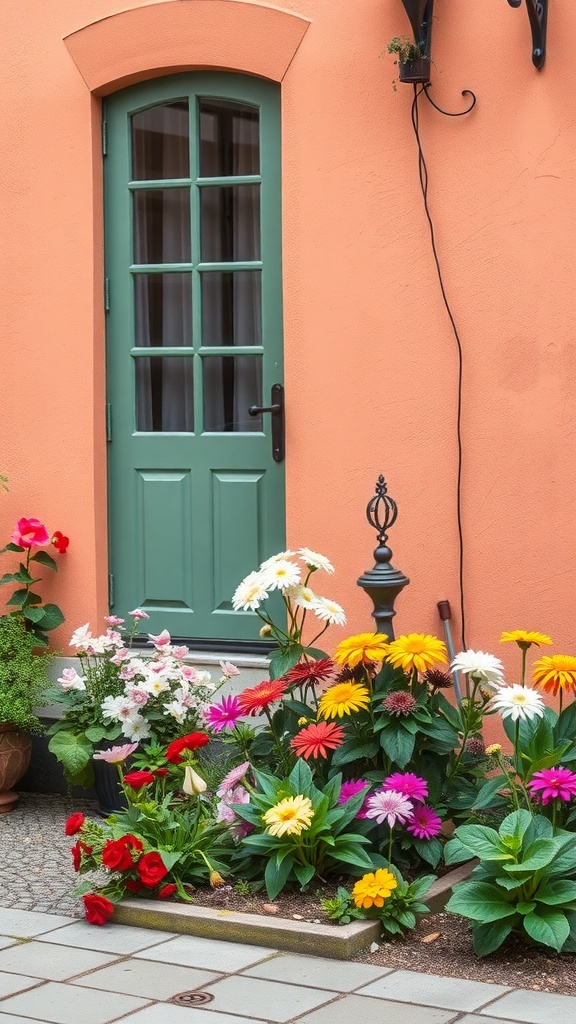
Color plays a big role in garden design. The image shows a charming entrance with a vibrant display of flowers. The bright blooms contrast beautifully with the soft peach wall and green door. This combination creates an inviting atmosphere.
Using colors that complement each other can make a small garden feel more spacious and lively. In this case, the greens of the plants and the door harmonize well with the colorful flowers. Shades of red, yellow, pink, and white add a cheerful touch, making the space feel warm and welcoming.
When planning your garden, think about how different colors can affect mood. For example, warm colors like red and yellow can energize a space, while cooler tones like blue and purple can create a sense of calm. Mixing these colors thoughtfully can enhance the overall look of your garden.
Creating a Focal Point
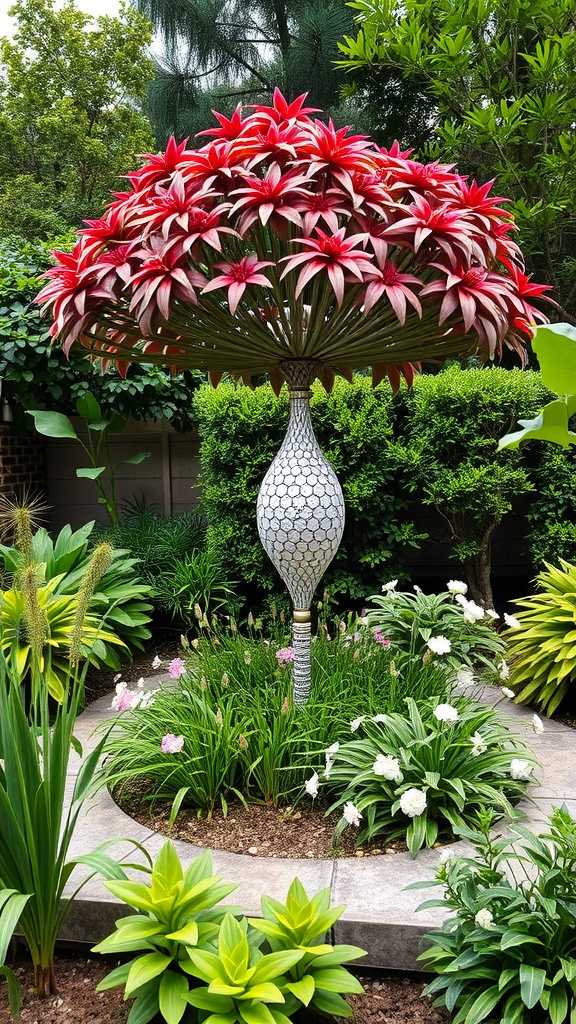
Creating a focal point in your small garden can make a big difference. The image shows a stunning centerpiece that draws the eye. This unique structure, resembling a flower, adds character and charm to the garden.
Notice how the vibrant red and green colors pop against the lush greenery. This contrast not only highlights the focal point but also enhances the overall beauty of the garden. Surrounding plants like the soft white flowers and leafy greens complement the centerpiece, creating a harmonious look.
When designing your garden, think about what you want to showcase. It could be a sculpture, a beautiful plant, or even a small water feature. The key is to make sure it stands out while still fitting in with the rest of your garden.
Incorporating a focal point can transform your space, making it feel more inviting and well-planned. So, take inspiration from this image and start thinking about your own unique centerpiece!
